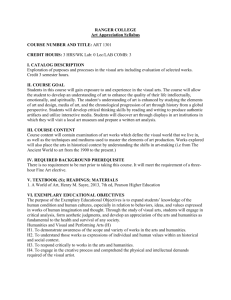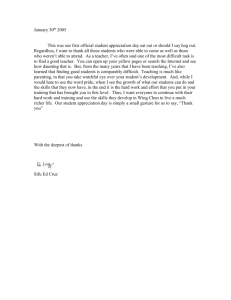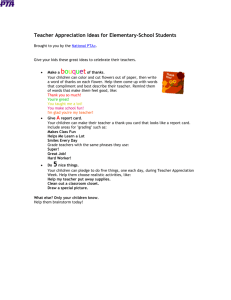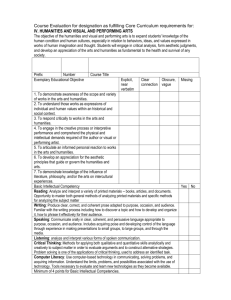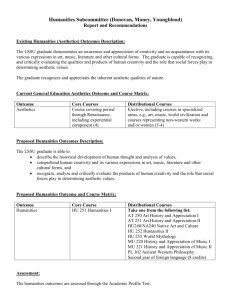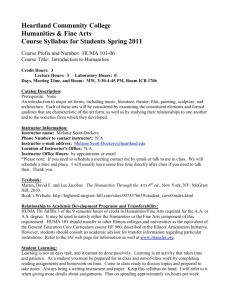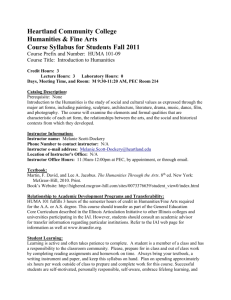course syllabus - Garland Independent School District
advertisement
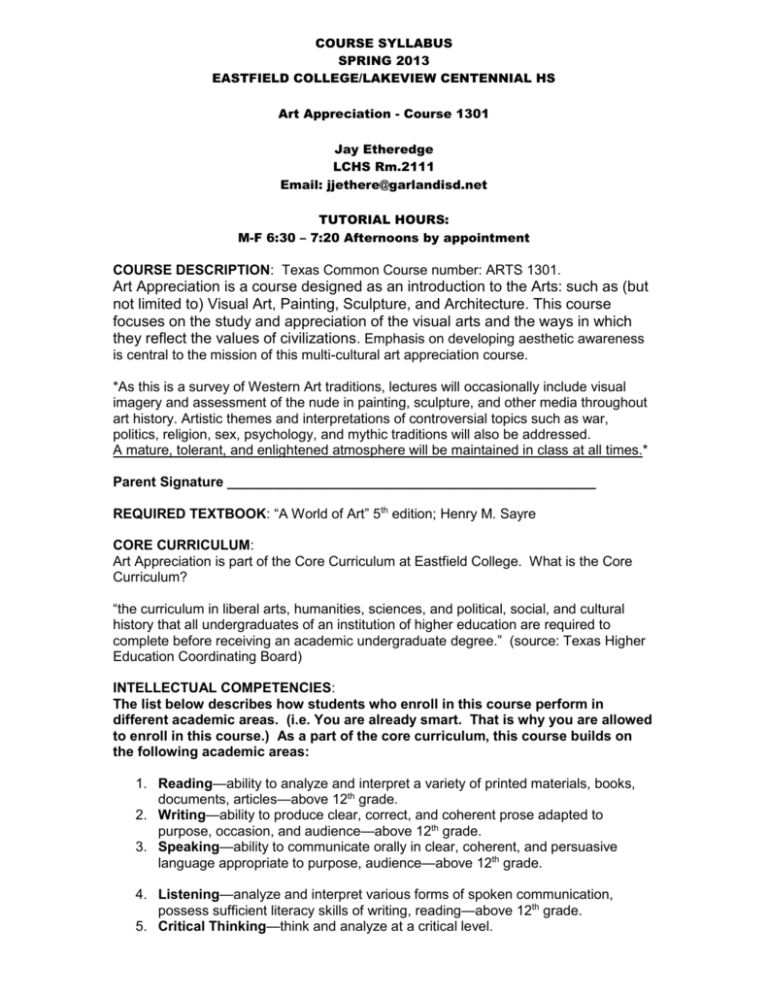
COURSE SYLLABUS SPRING 2013 EASTFIELD COLLEGE/LAKEVIEW CENTENNIAL HS Art Appreciation - Course 1301 Jay Etheredge LCHS Rm.2111 Email: jjethere@garlandisd.net TUTORIAL HOURS: M-F 6:30 – 7:20 Afternoons by appointment COURSE DESCRIPTION: Texas Common Course number: ARTS 1301. Art Appreciation is a course designed as an introduction to the Arts: such as (but not limited to) Visual Art, Painting, Sculpture, and Architecture. This course focuses on the study and appreciation of the visual arts and the ways in which they reflect the values of civilizations. Emphasis on developing aesthetic awareness is central to the mission of this multi-cultural art appreciation course. *As this is a survey of Western Art traditions, lectures will occasionally include visual imagery and assessment of the nude in painting, sculpture, and other media throughout art history. Artistic themes and interpretations of controversial topics such as war, politics, religion, sex, psychology, and mythic traditions will also be addressed. A mature, tolerant, and enlightened atmosphere will be maintained in class at all times.* Parent Signature ________________________________________________ REQUIRED TEXTBOOK: “A World of Art” 5th edition; Henry M. Sayre CORE CURRICULUM: Art Appreciation is part of the Core Curriculum at Eastfield College. What is the Core Curriculum? “the curriculum in liberal arts, humanities, sciences, and political, social, and cultural history that all undergraduates of an institution of higher education are required to complete before receiving an academic undergraduate degree.” (source: Texas Higher Education Coordinating Board) INTELLECTUAL COMPETENCIES: The list below describes how students who enroll in this course perform in different academic areas. (i.e. You are already smart. That is why you are allowed to enroll in this course.) As a part of the core curriculum, this course builds on the following academic areas: 1. Reading—ability to analyze and interpret a variety of printed materials, books, documents, articles—above 12th grade. 2. Writing—ability to produce clear, correct, and coherent prose adapted to purpose, occasion, and audience—above 12th grade. 3. Speaking—ability to communicate orally in clear, coherent, and persuasive language appropriate to purpose, audience—above 12th grade. 4. Listening—analyze and interpret various forms of spoken communication, possess sufficient literacy skills of writing, reading—above 12th grade. 5. Critical Thinking—think and analyze at a critical level. 6. Computer Literacy—understand our technological society, use computer-based technology in communication, solving problems, acquiring information. EXEMPLARY EDUCATIONAL OBJECTIVES: Core Exemplary Educational Objectives for Humanities and Visual/Performing Arts: 1. To demonstrate awareness of the scope and variety of works in the arts and humanities. 2. To understand those works as expressions of individual and human values within an historical and social context. 3. To respond critically to works in the arts and humanities. 4. To engage in the creative process or interpretive performance and comprehend the physical and intellectual demands required of the author or visual or performing artist. 5. To articulate an informed personal reaction to works in the arts and humanities. 6. To develop an appreciation for the aesthetic principles that guide or govern the humanities and arts. 7. To demonstrate knowledge of the influence of literature, philosophy, and/or the arts in other cultural contexts. LEARNING OUTCOMES: 1. Students will demonstrate an awareness of the scope and variety of artworks, styles and methods of production in class discussions, tests and writing assignments. 2. Students will form opinions on the social and cultural value of works of art as demonstrated in class discussions, tests and writing assignments. 3. Students will demonstrate an understanding of the importance of art museums, galleries and other cultural institutions within their communities. ASSIGNMENTS/TESTS/QUIZZES: During this semester, students will complete a variety of assessments in order to demonstrate an awareness of the course content. Below are the activities and their links to relevant Exemplary Educational Objectives. Students will complete multiple tests during the course of this semester. These tests will contain a mix of multiple choice and fill-in-the-blank questions. A summative Final Exam will be given which will include questions from previous tests. (There is no mystery about what will be on the Art Appreciation Final...save your unit tests and use them as study guides.) Students will write ongoing research papers relative to current subjects from week to week. These assignments will reflect the student’s best collegelevel writing. These assignments will be written in response to works of art or big ideas raised by the instructor, textbook author, or other written source. Research papers are usually 700-1000 words Occasional in-class projects will be incorporated into daily participation grades. These projects will be modest in scale but engaging for students to showcase their knowledge of a given Art unit. WRITING EXPECTATIONS NO CASUAL OR SOCIAL WRITING. You are not writing a text message or email. Writing style, spelling, punctuation, sentence structure, and word usage WILL affect your grade. College-level writing is hard work, but it is among the most crucial elements of one’s higher education. Without one’s absolute best effort at college-level writing it will be difficult to pass this course. All art history essays are to be turned in typed written, double spaced, sources cited, and in a 700-1000 word minimum format. A hardcopy is the only proper version that will be acceptable….NO EMAILED ESSAYS! . PLAGIARISM: Students must read the Plagiarism Statement in the Student Code of Conduct Definition: a piece of wring that has been copied from someone else and is present as being your own work. (dictionary.com) Any student using someone else’s thoughts, ideas or writing in their own work without giving proper credit (i.e. citing the source in the proper format) will be given an automatic failing grade for the assignment in question. Plagiarism is against Eastfield College & LCHS policy. Papers written by ANYONE other than the student seeking credit for the work will not be accepted and GIVEN A “ZERO”. Plagiarism and the Internet: Do not copy passages from the Internet and paste them into your papers. This is one of the most detectable methods of academic theft and will result in an instant failing grade. PLAGERISM SOFTWARE IS ROUTINELY EMPLOYED TO CATCH CHEATERS! The instructor reserves the right to give an assignment or test score of “F” to any student caught cheating or plagiarizing on tests. ACADEMIC HONESTY: The purpose of the Student Code of Conduct is to provide guidelines for the educational environment for GISD and The Dallas County Community College District. Students should be aware of disciplinary actions for all forms of academic dishonesty, including cheating, fabrication, facilitating academic dishonesty, plagiarism, and collusion. COURSE GRADE: 100-90= 89-80= 79-70= 69-60= A B C D 59 and below F TESTS: Each test will cover instructor lectures and power point discussions, videos, or other media. No partial credit will be given on any answers. Spelling must be correct. Writing must be college level. FINAL EXAM: SAVE ALL OF YOU RETURNED UNIT TESTS since the Final Exam questions will be “cherry-picked” from these past tests. Consequently you have ongoing review sheets with you at all times to study for the Final Exam. EXTRA CREDIT: There is no extra credit in this course. MAKE-UP POLICY: If you are legitimately absent, it is your responsibility to arrange tutorial time to take missed tests. There should be no missed tests, research papers or written critiques. The instructor reserves the right to change or revise the course syllabus.
